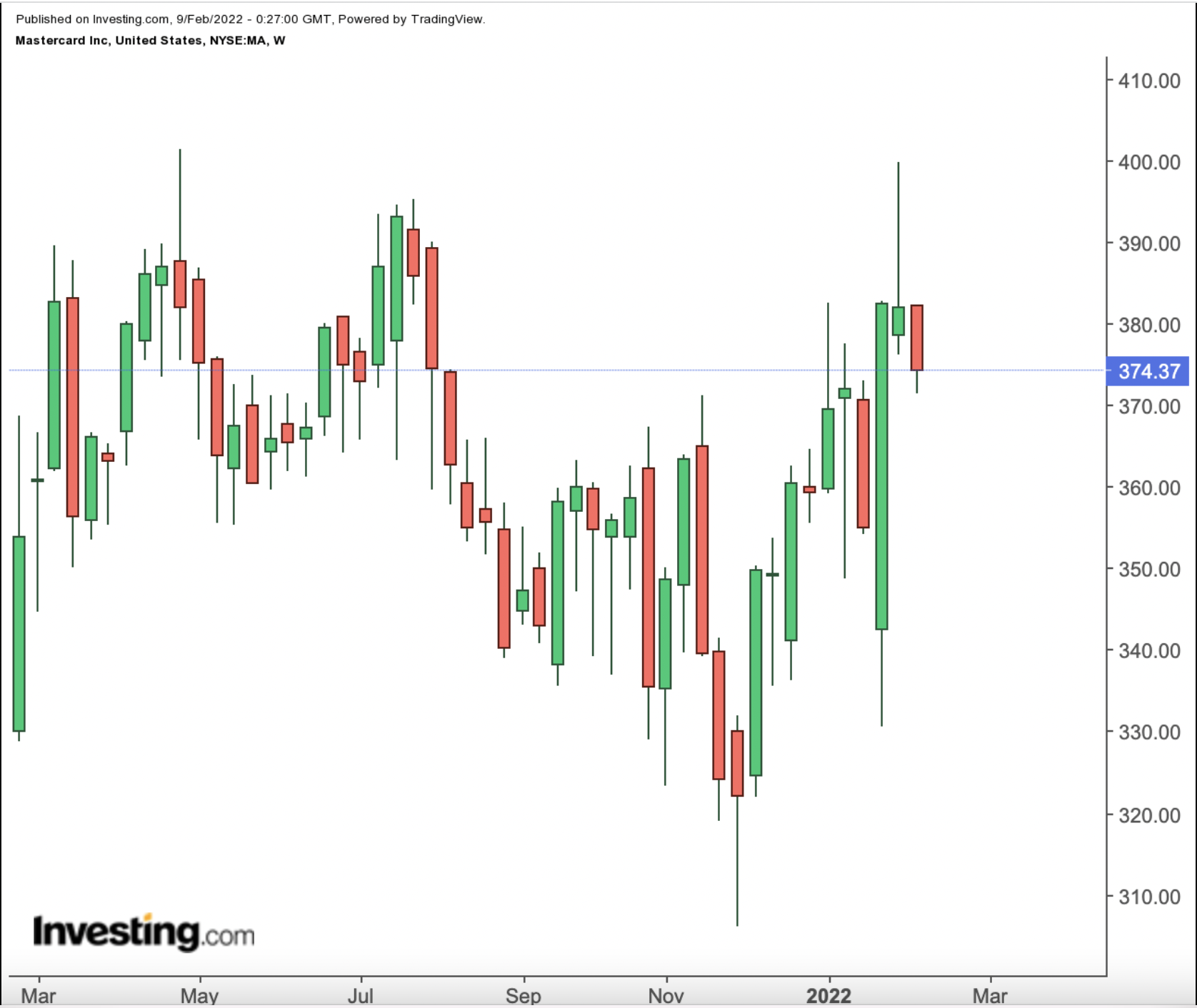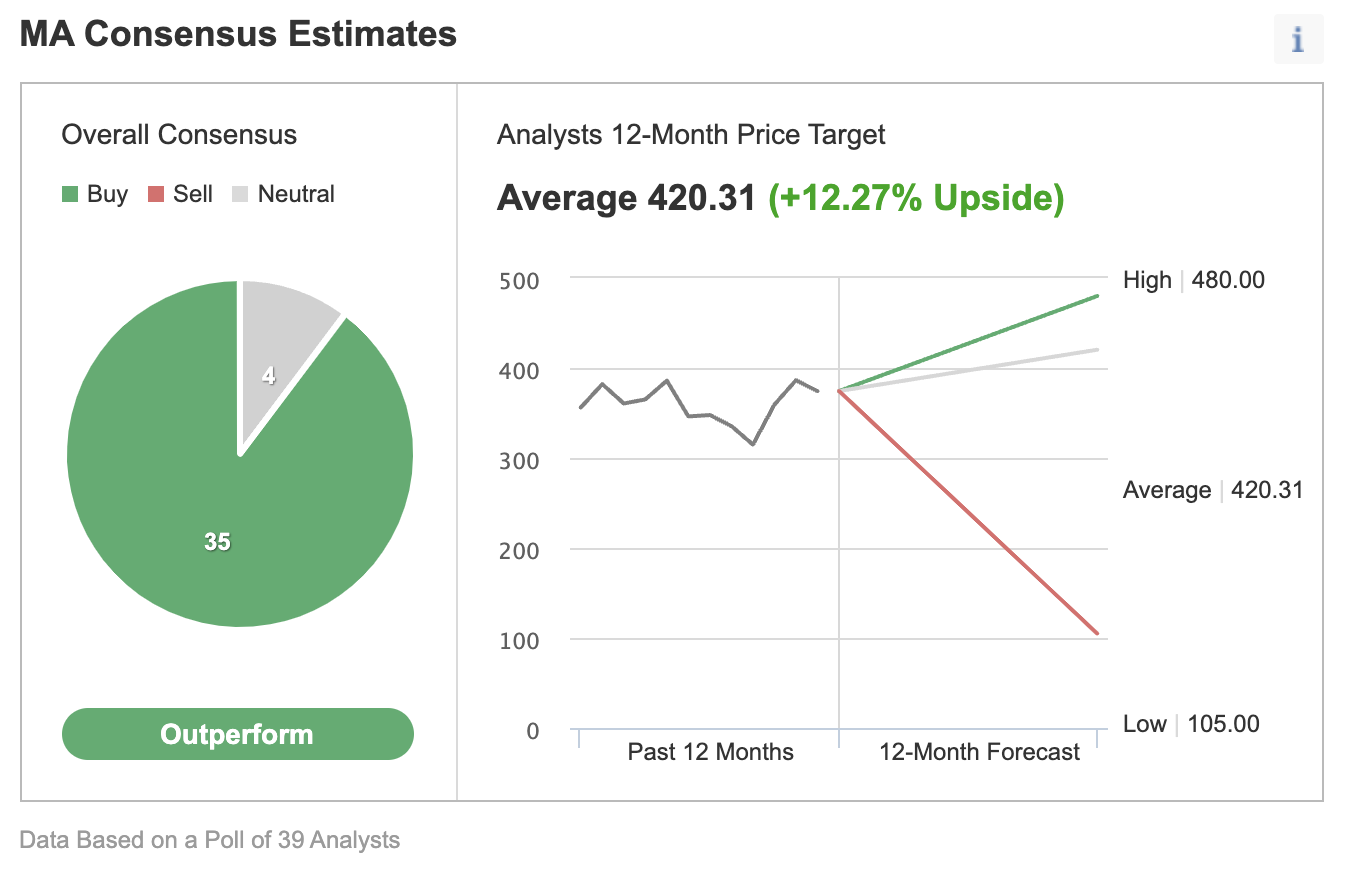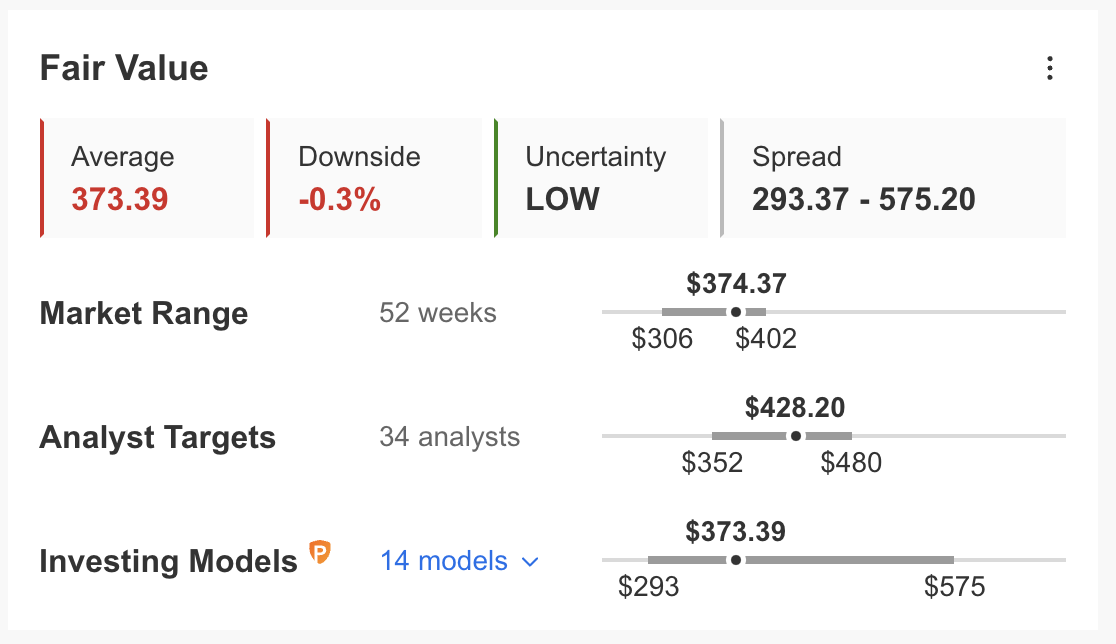- Payment processor Mastercard stock is up around 4.5% in 2022.
- Robust Q4 results contributed to the positive sentiment in MA stocks
- However, there could soon be profit-taking in Mastercard shares, pushing them toward $360. Such a potential decline would improve the margin of safety.
Shares of the financial services heavyweight Mastercard (NYSE:MA) are up more than 4.5% since the beginning of the year. The run-up in price has been welcome news for shareholders, even as broader indices suffered losses in the past six weeks. For instance, the S&P 500 declined 5.7% year-to-date and the Dow Jones U.S. Financials Index is flat.

On Apr. 28, 2021, MA shares went over $400 and hit a record high. But since then, the stock has come under pressure. The stock’s 52-week range has been $306.00 - $401.50, while the market capitalization of Mastercard stands at $366.83 billion.
Readers would be interested to know that shares of Visa (NYSE:V), Mastercard’s biggest rival, are also up 4.8% so far in 2022.
At this point, we should also highlight:
“A credit card network, such as Visa or Mastercard, sets the terms for credit card transactions, authorizes them and processes them. Meanwhile, a credit card issuer – usually a bank, a credit union or a similar financial institution – provides credit cards to consumers.”
In terms of market share, Visa has “nearly 50% of all credit cards in circulation in the U.S.” Mastercard’s market share is about 25%.
Meanwhile, another competitor, American Express (NYSE:AXP) shares have gained 16.1% so far this year, hitting a record high on Feb. 8. However, other fintech names, like PayPal (NASDAQ:PYPL) and Block (NYSE:SQ) lost 35.5% and 36.7% respectively YTD. In fact, both names hit 52-week lows on Feb. 8.
How Recent Metrics Came In
Mastercard announced robust Q4 financials on Jan. 27. Revenue was $5.2 billion, up 27% year-over-year. With consumer and cross-border spending rising, the company saw a 27% increase in purchase volume. Adjusted EPS came in at $2.35 versus $1.65 a year ago.
As well, in Q4, the financial services giant repurchased 3.7 million shares. It also paid $434 million in dividends.
On the results, CEO Michael Miebach said:
“We had a strong fourth quarter as spending trends continued to improve, with Q4 cross-border spending now above pre-pandemic levels. We are optimistic about the coming year.”
Prior to the release of the quarterly results, Mastercard stock was around $350. Wall Street has been pleased with the earnings results as well as the company’s robust balance sheet. On Feb. 8, Mastercard stock was changing hands shy of $375, and the current price supports a dividend yield of 0.52%.
Next Move In Mastercard Stock?
Among 39 analysts polled via Investing.com, MA shares have an “outperform” rating, with an average 12-month price target of $420.31. Such a move would imply an increase of around 12% from the current level. The target range is between $105 and $480.

Source: Investing.com
However, according to a number of valuation models like those that might consider P/E or P/S multiples, dividends or terminal values, the average fair value for Mastercard stock via InvestingPro stands at $373.39, or down about 1%.

Source: InvestingPro
Given the recent run-up in price, some investors might consider ringing the cash register on MA stock. Therefore, we could witness volatility in the coming weeks.
We expect Mastercard stock to potentially drop toward $360, or even less, in the short run. Following such a potential decline, MA shares are likely to trade sideways for several weeks until they establish a base, possibly between $355-$365, and then start a new leg up.
Therefore, Mastercard bulls with a two- to three-year horizon who are not concerned about short-term choppiness could consider buying the stock around these levels for long-term portfolios. Others, who are experienced with options strategies and believe there could be further declines in MA shares, might prefer to try a bear put spread.
However, option strategies are not suitable for all retail investors. Therefore, the following discussion is offered for educational purposes and not as an actual strategy to be followed by the average retail investor.
Bear Put Spread On MA Stock
Intraday price at time of writing: $374.80
In a bear put spread, a trader has a long put with a higher strike price and a short put with a lower strike price. Both legs of the trade have the same underlying stock (i.e. Mastercard) and the same expiration date.
The trader wants MA stock to decline in price. However, in a bear put spread, both the potential profit and the potential loss levels are limited. Such a bear put spread is established for a net cost (or net debit), which represents the maximum loss.
Let’s look at this example:
For the first leg of this strategy, the trader might buy an at-the-money (ATM) or slightly out-of-the-money (OTM) put option, like the MA Apr. 14, 370-strike put option. This option is currently offered at $17.80. It would cost the trader $1,780 to own this put option that expires in slightly over two months.
For the second leg of this strategy, the trader sells a MA put, like the Apr. 14, 360-strike put option. This option’s current premium is $13.75. The option seller would receive $1,375, excluding trading commissions.
Maximum Risk
In our example, the maximum risk will be equal to the cost of the spread plus commissions. Here, the net cost of the spread is $4.05 ($17.80 – $13.75 = $4.05).
As each option contract represents 100 shares of the underlying stock, we’d need to multiply $4.05 by 100, which gives us $405 as the maximum risk.
The trader could easily lose this amount if the position is held to expiry and both legs expire worthless, i.e., if the Mastercard stock price at expiration is above the strike price of the long put (or $370 in our example).
Maximum Profit Potential
In a bear put spread, potential profit is limited to the difference between the two strike prices minus the net cost of the spread plus commissions.
So in our example, the difference between the strike prices is $10 ($370 – $360 = $10). And as we have seen above, the net cost of the spread is $4.05.
The maximum profit, therefore, is $5.95 ($10.00 – $4.05 = $5.95) per share, less commissions. When we multiply $5.95 by 100 shares, the maximum profit for this option strategy comes to $595.
The trader will realize this maximum profit if the MA stock price is at or below the strike price of the short put (lower strike) at expiration, (or $360 in our example).
Short put positions are typically assigned at expiration if the stock price is below the strike price (i.e., $360 in this example).
However, there is also the possibility of early assignment. Therefore, the position would need monitoring up until expiration.
Break-Even MA Price At Expiration
Finally, we should also calculate the break-even point for this trade. At that price, the trade will not gain or lose any money.
At expiration, the strike price of the long put (i.e., $370 in our example) minus the net premium paid (i.e., $4.05 here) would give us the break-even price.
In this example: $370 − $4.05 = $365.95 (minus commissions).
Bottom Line:
We regard MA stock as a solid long-term choice for most portfolios. However, there could soon be short-term profit-taking in shares. Therefore, a trading strategy as outlined above might be appropriate for traders with a bearish outlook on Mastercard stock.
